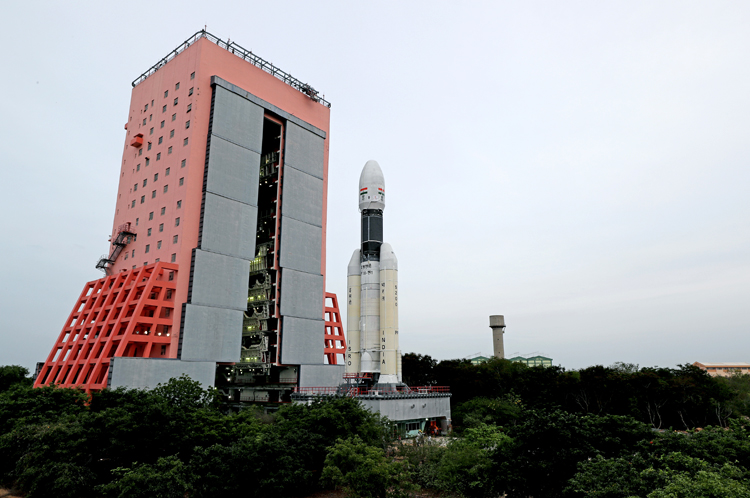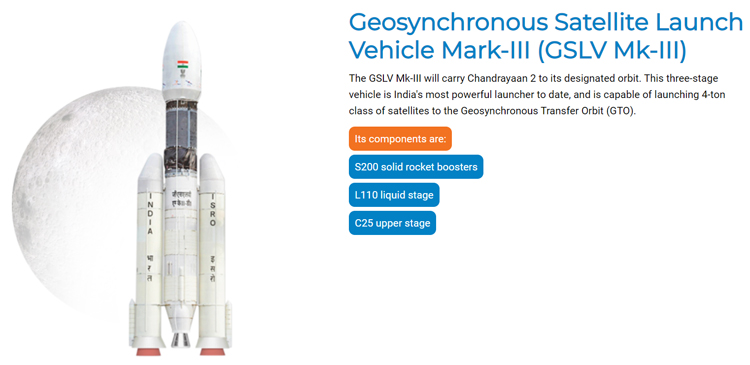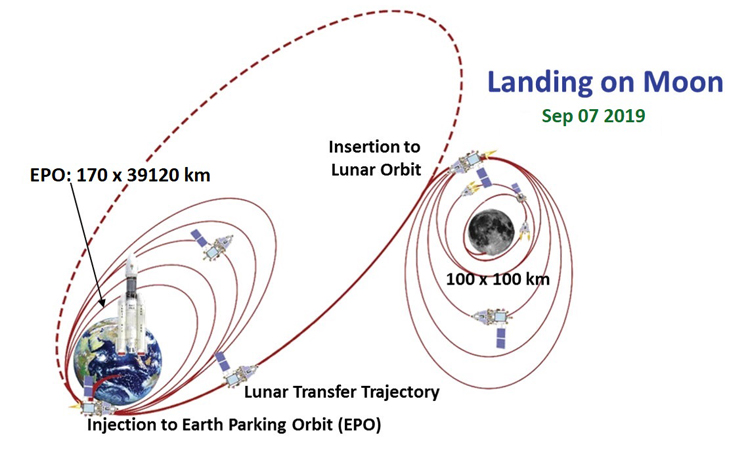Chandrayaan-2 lifts off; spacecraft successfully injected into Earth Orbit
India's first mission to land on the lunar surface will explore Moon's unexplored region- the South Pole and make India the fourth country globally to achieve soft-landing on Earth's only natural satellite.

On the afternoon of July 22, a Geosynchronous Satellite Launch Vehicle Mark III (GSLV Mk-III) rocket lifted off from the Satish Dhawan Space Centre (SDSC) in Sriharikota carrying India's ambitious mission to the moon, Chandrayaan-2. This is India's second mission to the moon and was previously scheduled to be launched last week on July 15. However, that time the launch vehicle suffered a technical snag about 56 minutes before the launch and it was rescheduled from July 15 to July 22. The 20-hour countdown began on the evening of July 21 at 18:43 hours IST for the launch which was planned on July 22 at 14:43 hours IST.
#ISRO#GSLVMkIII-M1 lifts-off from Sriharikota carrying #Chandrayaan2
— ISRO (@isro) July 22, 2019
Our updates will continue. pic.twitter.com/oNQo3LB38S
"On July 15, 2019 ISRO intelligently observed a technical snag, Team ISRO worked out, fixed and corrected the snag within 24 hours. For the next one and a half day, the required tests were conducted to ensure that corrections made were proper and in right direction. Today ISRO bounced back with flying colours," said ISRO (Indian Space Research Organisation) chief Dr. K.Sivan after GSLVMkIII-M1 successfully injected Chandrayaan-2 spacecraft into the earth orbit, having completed all three stages of the launch vehicle.
The spacecraft is now revolving round the earth with a perigee (nearest point to Earth) of 169.7 km and an apogee (farthest point to Earth) of 45,475 km. Today's flight marks the first operational flight of the GSLV Mk III.
"I am extremely happy to announce that the GSLVMkIII-M1 successfully injected Chandrayaan-2 spacecraft into Earth Orbit. It is the beginning of a historic journey of India towards moon & to land at a place near the South Pole to carry out scientific experiments," ISRO chief K Sivan added.
"Today is a historical day for Space Science and Technology in India. I am extremely happy to announce that GSLV MkIII-M1 successfully injected Chandrayaan-2 into an orbit of 6000 Km more than the intended orbit and is better.It is the beginning of a historic journey of India towards moon & to land at a place near the South Pole to carry out scientific experiments," Sivan added.

Embarked on a GSLV-Mk-III-M1, the 978 crore mission is aimed to land on the Moon on September 7, after several orbital phases. The three-stage vehicle, GSLV Mk-III, is India's most powerful launcher till date and is capable of launching 4-ton class of satellites to the Geosynchronous Transfer Orbit (GTO). For Chandrayaan-2, the GSLV MK-III-M1 will be carrying an Orbiter, a Lander (named Vikram) and a Rover (named Pragyaan) in a mission aiming to unveil lunar secrets.
— ISRO (@isro) July 22, 2019
People from across the country registered to watch the launch from the SDSC spaceport in Sriharikota, Andhra Pradesh, where a special gallery was made specifically for the launch. Many people had also gathered outside the launch center and thousands were glued on their screens to the live streaming. ISRO also continued the updates about each development on its twitter handle and shall continue to do so throughout the mission.
WHAT HAPPENS NOW?
About 16 minutes 14 seconds after lift-off, the vehicle injected Chandrayaan-2 spacecraft into an elliptical earth orbit. Immediately after spacecraft separation from the vehicle, the solar array of the spacecraft automatically got deployed and ISRO Telemetry, Tracking and Command Network (ISTRAC), Bengaluru successfully took control of the spacecraft.
Once it has been injected into the lunar orbit, the Chandrayaan-2 would go around the moon for a period of about 12 days. On the 48th day, i.e. September 7, the landing on the surface of the moon would be attempted when the Lander would separate from the orbiter and begin what Dr. Sivan said to be 'the most terrifying 15 minutes' of this mission.
Now the spacecraft would go around the earth for about 23 days. After this, a series of manoeuvres would be carried out to gradually raise the orbit and put Chandrayaan-2 on the lunar surface trajectory, which might take up to five days.
K Sivan said that Chandrayaan-2 will perform 15 crucial manoeuvres in the days to come.
#GSLVMkIII-M1 successfully injects #Chandrayaan2 spacecraft into Earth Orbit
— ISRO (@isro) July 22, 2019
Here's the view of #Chandrayaan2 separation#ISRO pic.twitter.com/GG3oDIxduG
Once it has been injected into the lunar orbit, the Chandrayaan-2 would go around the moon for a period of about 12 days. On the 48th day, i.e. September 7, the landing on the surface of the moon would be attempted when the Lander would separate from the orbiter and start what Dr. Sivan said to be 'the most terrifying 15 minutes' of this mission.

During these 15 minutes, Vikram would try to soft-land at an identified site on the lunar South Pole, which is a completely unexplored section of the Moon. This will indeed be the world's first space mission to conduct a soft landing on the Moon's South Polar Region, according to ISRO. The surface area in the South Polar Region of the Moon that remains in shadow is much larger compared to that in the North Polar Region. This makes the Moon's South Pole an area of special interest, hinting at the possibility of the presence of water in permanently shadowed areas around it. ISRO also informs that in addition, South Pole region has craters that are cold traps and contain a fossil record of the early Solar System. Moon's South Polar Region is also where India's first moon mission, Chandrayaan-1 had detected traces of water.
Prime Minister Narendra Modi congratulated the ISRO team and also tweeted about this unexplored expedition:
#Chandrayaan2 is unique because it will explore and perform studies on the south pole region of lunar terrain which is not explored and sampled by any past mission.
— Narendra Modi (@narendramodi) July 22, 2019
This mission will offer new knowledge about the Moon.
Post the landing, subsequently, the Rover will roll out and conduct experiments on the lunar surface for one lunar day which is equivalent to 14 Earth days while the orbiter will continue its mission for one year. The instruments on the Rover will analyze the surface and send back data. The orbiter will move around the Moon for remote sensing, while the various science payloads will gather information on lunar topography, mineralogy, elemental abundance, lunar exosphere and signatures of hydroxyl and water-ice.
The landing is crucial also because it marks the beginning of the 14-daylight period on the moon, which is critical for conducting experiments by the solar-powered Lander and Rover.
The landing is crucial also because it marks the beginning of the 14-daylight period on the moon, which is critical for conducting experiments by the solar-powered Lander and Rover.
The mission objective of Chandrayaan-2 is to develop and demonstrate the key technologies for end-to-end lunar mission capability, including soft-landing and roving on the lunar surface. On the science front, this mission aims to further expand our knowledge about the Moon through a detailed study of its topography, mineralogy, surface chemical composition, thermo-physical characteristics and atmosphere leading to a better understanding of the origin and evolution of the Moon.
The orbiter had a lift-off weight of about 2,369 kg, while the lander and rover weighed 1,477 kg and 26 kg respectively. The rover can travel up to 500 m (half a kilometre) and relies on electric power generated by its solar panel for functioning.
Chandrayaan-2 has several science payloads wit the Orbiter carrying eight payloads, the lander carrying three, and the rover two. Besides, a passive experiment is included on the lander.The Orbiter payloads will conduct remote-sensing observations from a 100 km orbit while the Lander and Rover payloads will perform in-situ measurements near the landing site.
The ground facilities constitute the third vital element of Chandrayaan-2mission. They perform the important task of receiving the health information as well as the scientific data from the spacecraft. They also transmit the radio commands to the spacecraft. The Ground Segment of Chandrayaan-2 consists of Indian Deep Space Network, Spacecraft Control Centre and Indian Space Science Data Centre.
This is India's maiden attempt to land on the lunar soil. As of now, only Russia, USA, and China have been successful in achieving soft-landing on the Moon. If successful, India would be the fourth country in the list.





